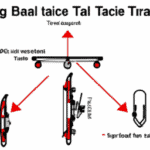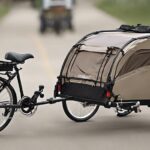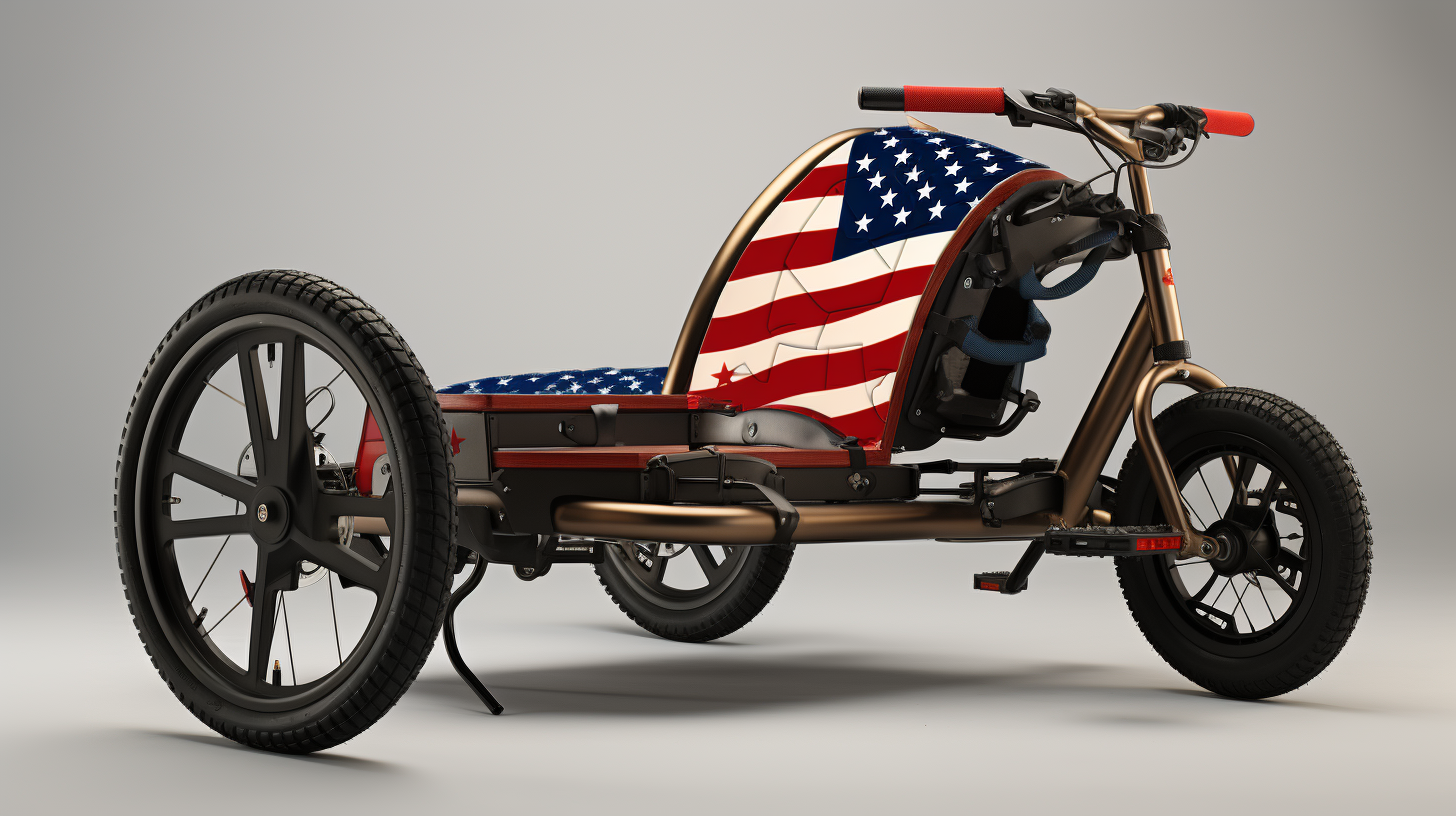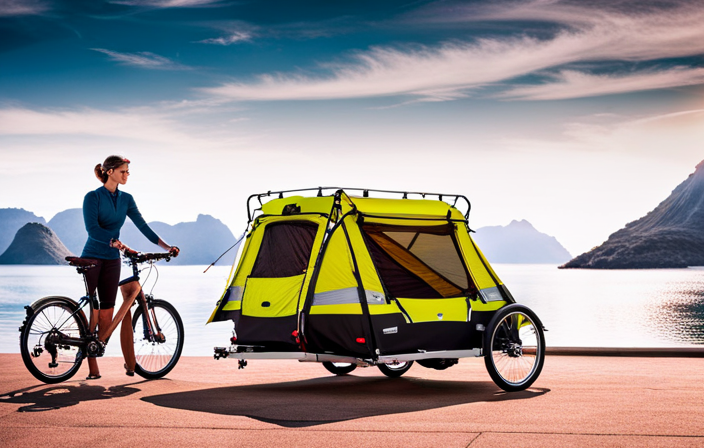As an avid cyclist, I’ve always found the task of connecting a bike trailer to be as smooth as a well-maintained chain.
In this article, I’ll guide you through the steps of how to hook a bike trailer to your bike, ensuring a safe and enjoyable ride.
From choosing the right trailer to maneuvering with ease, I’ll provide you with the technical know-how and precise instructions you need to embark on your bike trailer adventures.
So let’s pedal forward and get started!
Key Takeaways
- Understanding the different types of hitches available for bike trailers
- Ensuring proper attachment and alignment of the hitch coupler with the bike frame
- Testing the stability, maneuverability, and weight capacity of the attached trailer
- Regularly inspecting and maintaining the trailer’s components, including tires, brakes, and lights
Choose the Right Bike Trailer for Your Needs
When choosing the right bike trailer for your needs, it’s important to consider factors such as weight capacity and safety features. Comparing different bike trailer features is crucial in making an informed decision. Understanding the different types of bike trailers available will help you find the one that suits your specific requirements.
There are two main types of bike trailers: cargo trailers and child trailers. Cargo trailers are designed to carry items such as groceries, camping gear, or other cargo. They usually have a higher weight capacity compared to child trailers. On the other hand, child trailers are specifically designed to transport children. These trailers have safety features like harnesses and padded seats to ensure the comfort and well-being of your little ones.
When selecting a bike trailer, considering weight limits and storage capacity is essential. You need to ensure that the trailer can support the weight of your cargo or child. Additionally, evaluating the durability and stability of bike trailers is crucial for a safe and reliable ride.
To familiarize yourself with the bike trailer components, it’s important to understand how they are assembled and attached to your bike. By doing so, you can ensure a secure connection and a smooth ride.
Familiarize Yourself with the Bike Trailer Components
Before you begin, make sure to familiarize yourself with all the components of the bike trailer. Understanding the various parts and how they work together is crucial for ensuring safe and efficient use of the trailer.
Here are the key components of a bike trailer:
-
Frame: The frame is the backbone of the trailer, providing structure and support. It is usually made of lightweight yet durable materials such as aluminum or steel.
-
Wheels: Bike trailers typically have two wheels, which allow for smooth and stable movement. The size and type of wheels may vary depending on the trailer model.
-
Hitch: The hitch is what attaches the trailer to your bike’s rear axle or seat post. There are different types of hitches, including universal hitches and specific ones designed for certain bike models.
-
Safety features: Bike trailers often come with safety features such as reflectors, flags, and visibility strips. These help increase visibility and ensure that you and your trailer are seen by other road users.
-
Cargo compartment: The cargo compartment is where you place your belongings or passengers. It is usually spacious and designed to accommodate various items securely.
By familiarizing yourself with these components, you will be better equipped to understand bike trailer safety and how different types of attachments work.
Now, let’s move on to the next section, where we will discuss how to ensure your bike is compatible with a trailer.
Ensure Your Bike is Compatible with a Trailer
To ensure compatibility with a trailer, you’ll want to check if your bicycle has the necessary attachment points. Choosing the right trailer hitch is crucial for a secure connection between your bike and the trailer. There are different types of hitches available, such as seat post hitches, axle hitches, and frame hitches. Each type has its own advantages and installation requirements, so it’s important to choose the one that suits your bike’s design and specifications.
In addition to selecting the appropriate hitch, ensuring proper weight distribution is essential for a smooth and safe ride. Most bike trailers have a weight limit, so it’s important to distribute the load evenly to avoid putting too much strain on your bike. Make sure to place heavier items at the bottom and towards the center of the trailer to maintain balance and stability.
Now that you understand the importance of compatibility and weight distribution, let’s move on to preparing your bike for attachment.
Prepare Your Bike for Attachment
Make sure you’ve checked for any loose or damaged parts before attaching the trailer. Ensuring the safety of your bike trailer attachment is crucial for a smooth and secure ride. Here are some important steps to prepare your bike for attachment:
-
Check the compatibility: Ensure that your bike is compatible with the bike trailer you are using. Refer to the manufacturer’s instructions or consult with a professional if needed.
-
Inspect the bike frame: Examine the bike frame for any cracks, dents, or other damages that could affect the attachment process. Repair or replace any damaged parts before proceeding.
-
Check the tires and brakes: Ensure that your bike tires are properly inflated and in good condition. Make sure the brakes are functioning correctly to ensure optimal safety.
-
Secure any loose items: Before attaching the trailer, remove any loose accessories, such as water bottles or bike bags, that could interfere with the attachment process or pose a safety risk.
Now that your bike is ready, you can proceed to attach the trailer hitch to your bike’s rear axle. By following these preparation steps, you are ensuring the safety and stability of your bike trailer attachment.
Attach the Trailer Hitch to Your Bike’s Rear Axle
Once you’ve checked the compatibility and inspected your bike frame, it’s time to attach the trailer hitch to your bike’s rear axle.
Choosing the right trailer hitch is crucial to ensure a secure and safe attachment. Look for one that is specifically designed for your bike model and trailer type.
To begin, locate the rear axle of your bike. This is the metal rod that passes through the center of the rear wheel. The trailer hitch will attach to this axle, providing a stable connection between your bike and the trailer.
Start by loosening the nuts on the axle, but be careful not to remove them completely. Slide the hitch onto the axle, making sure it sits snugly against the frame. Once in place, tighten the nuts back onto the axle, ensuring that the hitch is securely fastened.
Now, you can troubleshoot any issues that may arise during the attachment process. If the hitch seems loose or wobbly, double-check that it is properly aligned and tightened. Additionally, make sure there is enough clearance between the hitch and the bike frame, as any contact could cause damage.
With the trailer hitch securely attached to your bike’s rear axle, you are now ready to move on to the next step of securing the hitch to your bike frame.
Secure the Trailer Hitch to Your Bike Frame
Now that you’ve attached the trailer hitch to your bike’s rear axle, it’s time to ensure a secure connection by fastening it to your bike frame. This step is crucial to ensure the stability and safety of your bike trailer while in use.
To achieve a secure connection, you need to choose the right bike trailer for your needs and familiarize yourself with the bike trailer components.
One important component to consider is the hitch coupler, which connects the trailer arm to the bike frame. It is essential to ensure that the hitch coupler is compatible with your bike’s frame design. Some bike trailers come with universal hitches that fit most bike frames, while others require specific adapters or attachments.
To fasten the hitch coupler to your bike frame, follow these steps:
- Position the hitch coupler on the bike frame’s seat stays or rear dropouts.
- Align the holes on the hitch coupler with the corresponding holes on the bike frame.
- Insert the hitch pin through the aligned holes.
- Secure the hitch pin in place by tightening the locking mechanism.
Connect the Trailer Arm to the Hitch
To ensure a secure connection, it’s important to properly attach the trailer arm to the hitch coupler. Connecting the trailer arm to the hitch is a critical step in setting up your bike trailer. Begin by positioning the trailer arm near the hitch coupler, making sure that it is aligned correctly. The hitch coupler should be open and ready to receive the trailer arm. Slide the trailer arm into the coupler, ensuring that it is fully inserted. You should hear a click or feel a slight resistance when it is properly attached.
Once the trailer arm is connected to the hitch, it’s important to adjust its length and position. This will ensure that the bike and trailer are properly aligned and balanced. To adjust the length, locate the adjustment mechanism on the trailer arm. It may be a lever or a latch that allows you to extend or retract the arm. Adjust the length according to your preference and the size of the trailer.
In addition to adjusting the length, you may also need to adjust the position of the trailer arm. This is particularly important if you have a single-wheel trailer, as it needs to be aligned with the bike’s rear wheel. To adjust the position, loosen the bolts or screws that secure the arm in place. Move the arm to the desired position and tighten the bolts or screws to secure it.
Now that the trailer arm is properly connected and adjusted, let’s move on to the next step: adjusting the trailer arm height and angle.
Adjust the Trailer Arm Height and Angle
Make sure you properly adjust the height and angle of the trailer arm to ensure optimal alignment and balance. The trailer arm height is an essential factor in connecting the bike trailer to your bike.
To adjust the height, locate the height adjustment mechanism on the trailer arm. Most bike trailers have a quick-release lever or a pin system for adjusting the height. Simply loosen the lever or remove the pin, slide the trailer arm up or down, and secure it in the desired position. Ensure that the trailer arm is at a height that allows the trailer to ride level and parallel to the ground.
In addition to adjusting the height, you may also need to make trailer arm angle adjustments. The angle of the trailer arm determines the distance between the bike and the trailer. To adjust the angle, locate the angle adjustment mechanism on the trailer arm. This mechanism is usually a bolt or a lever that allows you to change the angle of the arm. Loosen the bolt or lever, adjust the angle, and tighten it back to secure the arm in place.
Now that you have adjusted the height and angle of the trailer arm, you can proceed to attach the trailer to the trailer arm securely.
Attach the Trailer to the Trailer Arm
After adjusting the height and angle of the trailer arm, you can securely attach the trailer to it. To do this, locate the hitch coupler on the trailer arm. The hitch coupler is designed to fit onto the bike’s rear axle. Align the coupler with the axle and slide it onto the axle until it fits snugly. Ensure that the coupler is fully engaged and that the safety pin is securely inserted to prevent accidental detachment.
Next, check the trailer arm angle. The angle of the trailer arm should be adjusted so that it is parallel to the ground. If the angle is too high, it can cause instability and affect the bike’s handling. Conversely, if the angle is too low, it may cause the trailer to scrape against the ground during turns. Use the adjustable arm mechanism to fine-tune the angle until it is parallel to the ground.
Troubleshooting trailer attachment is essential for a safe and secure ride. Ensure that the hitch coupler is securely attached to the bike’s rear axle and that the safety pin is properly inserted. Double-check the trailer’s stability and security by giving it a gentle tug to make sure it is firmly attached.
In the next section, we will discuss the importance of double-checking the trailer’s stability and security before setting off on your ride.
Double-Check the Trailer’s Stability and Security
Ensure that the hitch coupler is securely attached to the rear axle and that the safety pin is properly inserted, as this will help maintain the stability and security of the trailer. Before embarking on your bike ride with a trailer in tow, it is crucial to double-check the trailer’s stability and security. There are two important aspects to consider: the trailer’s weight capacity and the proper inflation of its tires.
To ensure that the trailer is capable of safely carrying your load, it is essential to double check its weight capacity. This information can usually be found in the trailer’s manual or on its manufacturer’s website. Exceeding the trailer’s weight limit can jeopardize its stability and increase the risk of accidents.
Additionally, it is crucial to ensure that the trailer’s tires are properly inflated. Insufficient tire pressure can result in poor handling, decreased stability, and increased rolling resistance. Properly inflated tires will provide better traction and a smoother ride.
To make it easier to visualize and understand, here is a table summarizing the steps to double-check the trailer’s stability and security:
| Steps |
|---|
| Ensure hitch coupler is securely attached |
| Confirm safety pin is properly inserted |
| Double check the trailer’s weight capacity |
| Ensure the trailer’s tires are properly inflated |
Test the Trailer’s Attachment by Riding Slowly
Once you’ve double-checked the stability and security of the trailer, it’s time to test its attachment by riding slowly. This step is crucial to ensure that the trailer is properly connected to your bike and won’t come loose during your ride.
To test the trailer’s stability, start by riding on a flat and smooth surface. Begin at a slow and steady pace, gradually increasing your speed to see how the trailer responds. Pay close attention to any wobbling or swaying motions. If you notice any instability, stop immediately and recheck the attachment points.
Ensure that the hitch is securely fastened to your bike’s rear axle or seat post, depending on the type of trailer you have. Additionally, make sure that the safety strap or secondary attachment is properly secured to prevent the trailer from detaching in case the hitch fails.
Practice Maneuvering with the Attached Trailer
After successfully testing the attachment of the bike trailer by riding slowly, it’s time to move on to the next step: practicing maneuvering with the attached trailer. This is an essential part of learning how to effectively handle the bike trailer and ensure a smooth and safe ride.
To master this skill, I recommend following these practice techniques and safety precautions:
- Start in an open and spacious area free from any obstacles or traffic.
- Begin by pedaling slowly and gradually increasing your speed as you gain confidence.
- Practice making turns, both wide and tight, to get a feel for how the trailer responds.
- Experiment with stopping and starting to understand the additional weight and how it affects your bike’s handling.
- Gradually introduce challenging terrain such as hills or uneven surfaces to further enhance your control and stability.
Remember, safety should always be a top priority when practicing with a bike trailer. So, make sure to:
- Wear a properly fitted helmet and other protective gear.
- Keep a safe distance from other cyclists, pedestrians, and vehicles.
- Maintain a steady and controlled speed to avoid sudden movements.
- Be aware of your surroundings at all times and anticipate any potential hazards.
- Communicate your intentions to other road users by using hand signals and clear verbal cues.
By following these practice techniques and safety precautions, you’ll be well-prepared to confidently maneuver your bike trailer in various situations.
Now, let’s move on to the next section where we will discuss the importance of following safety guidelines and regulations without compromising on fun and enjoyment.
Follow Safety Guidelines and Regulations
To stay safe while using a bike trailer, it’s important to familiarize yourself with and follow the safety guidelines and regulations. Bike trailer safety is crucial to ensure the well-being of both you and your precious cargo. Before you hit the road, make sure to choose the right bike trailer for your needs. Consider factors like weight capacity, stability, and ease of attachment to your bike. Always adhere to the manufacturer’s guidelines for proper installation and usage.
Regulations and guidelines regarding bike trailer safety can vary depending on your location. It’s essential to research and understand the specific rules and regulations in your area. For example, some jurisdictions may require helmets for all passengers, while others may have age or weight restrictions. Familiarize yourself with these rules and ensure compliance to avoid any potential legal issues.
Additionally, always prioritize the safety of your passengers. Make sure they are securely strapped into the trailer using the provided harnesses or seat belts. Double-check that the hitch connecting the bike and trailer is properly secured and locked in place. Regularly inspect the trailer’s tires, brakes, and lights to ensure they are in good working condition.
Maintain and Inspect Your Bike Trailer Regularly
Regularly checking the condition of your bike trailer is essential for ensuring the safety of your passengers. This includes inspecting the tires, brakes, and lights. Proper maintenance is crucial for a smooth and enjoyable ride. By conducting regular inspections, you can identify any potential issues and address them promptly.
Inspecting the tires is important because they are the only point of contact between the trailer and the road. Check for signs of wear, such as cracks or bulges, and make sure they are properly inflated. The brakes play a vital role in controlling the trailer’s speed, so it is important to ensure they are functioning correctly and not worn out. Additionally, inspect the lights to ensure they are working properly, as they enhance visibility and promote safety, especially during low-light conditions.
Regular maintenance and inspections offer several benefits. They help prevent accidents by identifying and addressing potential issues before they become major problems. They also extend the lifespan of your bike trailer, saving you money in the long run. By taking the time to maintain and inspect your bike trailer regularly, you can enjoy your bike trailer adventures with peace of mind, knowing that you have done everything possible to ensure the safety and well-being of your passengers.
Enjoy Your Bike Trailer Adventures!
You can have a blast on your bike trailer adventures! Here are some safety tips to keep in mind and factors to consider when choosing the right size bike trailer:
-
Safety Tips:
- Always ensure that your bike trailer is properly attached to your bicycle. Check the hitch connection and make sure it is secure before each ride.
- Maintain a safe speed and avoid sudden movements to prevent tipping over or causing imbalance.
- Use reflective gear and lights to enhance visibility, especially when riding in low light conditions.
-
Choosing the Right Size Bike Trailer:
- Consider the number of children or cargo you will be transporting. Bike trailers come in different sizes and weight capacities, so choose one that can accommodate your needs.
- Check the dimensions of the trailer to ensure it fits comfortably behind your bike without obstructing your riding or turning abilities.
- Look for trailers with adjustable seats and harness systems to provide a secure and comfortable ride for your passengers.
Frequently Asked Questions
How do I choose the right bike trailer for my needs?
When choosing the right bike trailer for my needs, I consider several factors.
First, I look at the weight capacity to ensure it can accommodate my cargo or child.
Next, I evaluate the type of hitch system, such as a universal or quick-release design, to ensure compatibility with my bike.
I also consider the trailer’s suspension, storage options, and safety features.
Different types of bike trailers, including cargo and child trailers, have their own pros and cons, so it’s important to weigh these factors before making a decision.
What are the components of a bike trailer that I should familiarize myself with?
When familiarizing myself with a bike trailer, it’s important to understand its various components.
These include:
- The frame: It provides structure and support.
- The wheels: They enable smooth movement.
- The hitch: It connects the trailer to the bike, allowing it to be towed.
- The attachment mechanism: It securely fastens the trailer to the bike frame.
Understanding these bike trailer parts is crucial for proper installation and safe operation.
How can I ensure that my bike is compatible with a trailer?
To ensure bike trailer compatibility, it’s important to consider the type of attachment system your bike has. Most bike trailers attach to the rear wheel axle or seat post. Check if your bike has a quick-release skewer or a solid axle, as this will determine the type of attachment required.
Additionally, consider the weight capacity of your bike’s rear wheel and choose a trailer that is within that limit. It’s crucial to follow the manufacturer’s guidelines for proper bike trailer attachment.
What steps should I take to prepare my bike for attachment of a trailer?
To ensure a smooth bike trailer attachment, it’s crucial to properly prepare your bike. Start by checking the frame and rear axle for any signs of wear or damage.
Make sure the tires are properly inflated and the brakes are in good working condition.
Next, attach the hitch to the rear axle, ensuring it’s securely fastened.
How do I maintain and inspect my bike trailer regularly?
To maintain and inspect my bike trailer regularly, I follow a few steps.
Firstly, I clean the trailer after each use to remove any dirt or debris.
Then, I check the tires for proper inflation and wear.
Next, I inspect the frame for any signs of damage or rust.
Additionally, I ensure that all the nuts and bolts are tightened securely.
Conclusion
After ensuring the compatibility and attaching the trailer hitch to my bike’s rear axle, I embarked on my bike trailer adventure.
As I pedaled forward, the trailer followed seamlessly, like a loyal companion on a journey. The smooth maneuvering allowed me to effortlessly navigate through the winding paths, feeling the wind in my hair and the sun on my face.
With the safety guidelines in mind, I could fully enjoy the beautiful scenery and the freedom that my bike trailer provided.
Regular maintenance and inspection will ensure many more memorable adventures in the future.
















